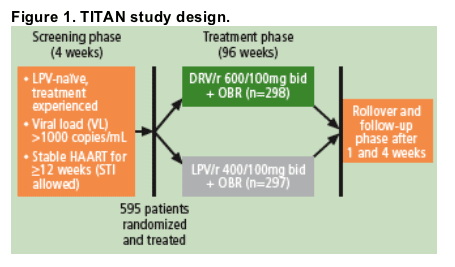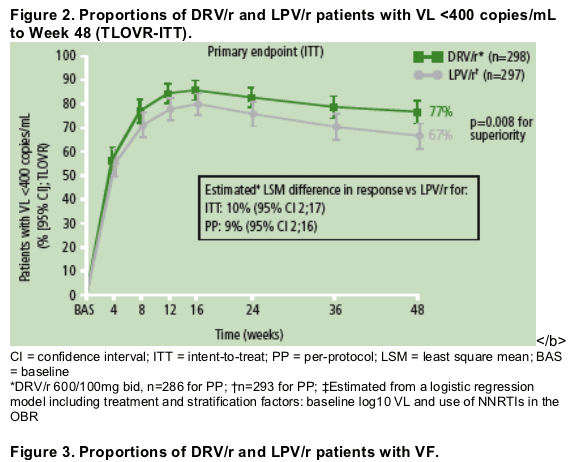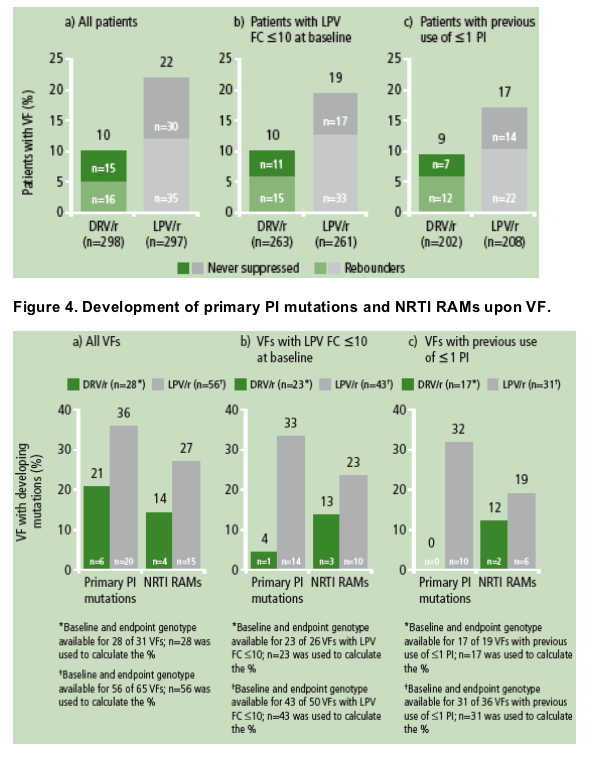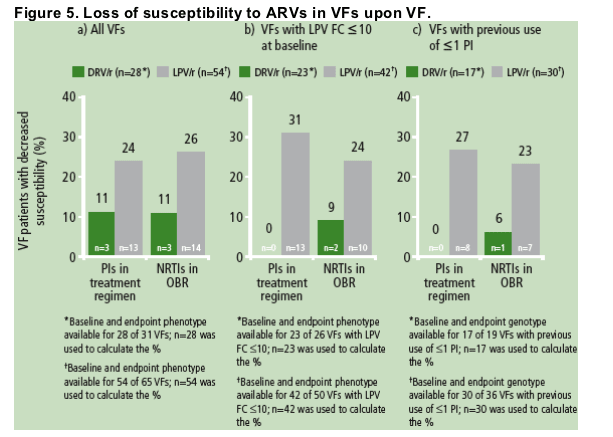 |
 |
 |
| |
Development of resistance in patients with virologic failure (VF) on darunavir/ritonavir (DRV/r) or lopinavir/ritonavir (LPV/r): results of a randomized, controlled, Phase III trial in treatment-experienced patients (TITAN)
|
| |
| |
Reported by Jules Levin
ICAAC Sept 17-20, 2007, Chicago
S De Meyer,1 E De Paepe,1 T Vangeneugden,1 B Van Baelen,1 S Spinosa-Guzman,1 E Lefebvre,2 D Miralles,1 E Lathouwers,1 MP de Bethune1
1Tibotec BVBA, Mechelen, Belgium; 2Janssen-Cilag, Amsterdam, The Netherlands
AUTHOR CONCLUSIONS
- In this LPV-naive, treatment-experienced TITAN patient population, twice as many patients receiving LPV/r had VF compared with those receiving DRV/r
- even after excluding patients with LPV FC >10 or those with previous use of two or more PIs, twice as many patients receiving LPV/r had VF compared with those receiving DRV/r.
- Fewer VFs receiving DRV/r developed primary PI mutations and NRTI RAMs compared with VFs receiving LPV/r
- this conclusion remains true when patients with LPV FC >10 or patients who previously used >/=2 PIs were excluded.
- Compared with LPV/r and following VF, DRV/r-based therapy was associated with lower rates of loss of susceptibility to the PI or NRTI(s) in the treatment regimen. These findings suggest that in the TITAN study, DRV/r was more effective than LPV/r at protecting the treatment 'backbone' and more likely to retain phenotypic susceptibility upon VF
- when patients with LPV FC >10 or patients who previously used >/=2 PIs were excluded, none of the VFs on DRV/r treatment lost susceptibility to DRV, while loss of LPV susceptibility was still observed in VFs on LPV/r treatment
- when patients with LPV FC >10 or patients who previously used >/=2 PIs were excluded, VFs receiving LPV/r still experienced a greater loss of susceptibility to NRTIs in the treatment regimen compared with DRV/r.
- These findings suggest that DRV has a high genetic barrier to the development of resistance and that the earlier use of DRV/r may better preserve future treatment options.
INTRODUCTION
- The new HIV-1 protease inhibitor (PI), darunavir (DRV; TMC114), has significant in-vitro antiretroviral (ARV) activity against both wild-type virus and multidrug-resistant HIV-1 strains.1
- DRV possesses a high genetic barrier1 defined as the drug's ability to delay the development of resistance and to retain antiviral activity despite the occurrence of mutations within the viral target protein.
- DRV/r at a dose of 600/100mg bid has been approved in the USA2 and other countries including those in Europe3 for the treatment of HIV-1 infection in treatment-experienced adult patients.
- TITAN (TMC114-C214; TMC114/r In Treatment-experienced pAtients Naive to LPV) is an ongoing Phase III trial designed to assess the efficacy and safety of DRV/r versus LPV/r in patients with a broad range of treatment experience, typical of that encountered in a clinical setting.4
- The emergence of resistance to highly active ARV therapy (HAART) presents a significant challenge to managing HIV-1 infection.
- This poster studies development of resistance in TITAN patients experiencing VF with DRV/r or LPV/r.
METHODS
Design and patient population
- TITAN is a randomized, controlled, 96-week, ongoing Phase III trial designed to assess the efficacy and safety of DRV/r versus LPV/r in LPV-naive, treatment-experienced, HIV-1-infected patients.
- The primary objective of the trial was to establish non-inferiority of DRV/r versus LPV/r at Week 48 with VL <400 copies/mL.
- Patients with HIV-1 RNA >1000 copies/mL and treated with their current HAART for >12 weeks were randomized to receive an optimized background regimen (OBR) consisting of 2-3 ARVs (NRTIs with or without NNRTIs; enfuvirtide was disallowed) plus either DRV/r 600/100mg bid or LPV/r 400/100mg bid (Figure 1)
- patients on a structured treatment interruption (STI) of >4 weeks were also permitted to enroll.
- Patients with previous or current use of LPV, DRV, tipranavir or enfuvirtide and current use of investigational ARV drugs were excluded from the trial.

Virologic analysis
- Analyses were performed on the dataset from the primary analyses with a cut-off date of January 17 2007, at which time all patients had reached Week 48 of treatment or discontinued earlier.
- Viral phenotypic (Antivirogram) and genotypic determinations were performed by Virco BVBA (Mechelen, Belgium).
- Phenotypic resistance was defined as having a fold-change in EC50 (FC) above the biologic/clinical cut-off (Antivirogram). The clinical cut-off of 10 was used for both DRV5 and LPV.6
- All lists of mutations were based on the IAS-USA lists.7
- The development of resistance at endpoint (i.e. the last available timepoint with a genotype/phenotype during the treatment period) compared with baseline was studied in patients who experienced VF
- the development of a mutation was defined as a mutation that could be detected by resistance testing at endpoint, but was not detected at baseline
- the loss of susceptibility to an ARV was defined as having a FC above the biologic/clinical cut-off at endpoint while not at baseline.
- VFs were defined as rebounders (loss of HIV-1 RNA <400 copies/mL) and those that were never suppressed (HIV-1 RNA <400 copies/mL never achieved).
- The time-to-loss of virologic response (TLOVR; non-VF censored) imputation method was used for the identification of VF, meaning that data were not imputed at timepoints after discontinuation for patients who discontinued for reasons other than VF (non-VF). Moreover, patients who discontinued before Week 16 were not taken into account to determine VF.
- As some patients in TITAN had decreased susceptibility to LPV at baseline despite being LPV/r naive, a subanalysis was conducted that excluded patients with FC >10 to LPV. In addition, some patients in TITAN had previous use of two or more PIs; these patients were also excluded to provide another subanalysis.
RESULTS
Baseline characteristics
- A total of 595 patients were randomized and treated, of these, 31% had not used PIs previously. Eighty-two percent of baseline isolates were susceptible to >/=4 PIs.
- Virologic baseline characteristics are shown in Table 1.

- All patients were LPV-naive at study entry; baseline characteristics showed that
- at baseline, 98.5% of patients were fully susceptible to DRV (FC
- baseline demographics and treatment history were similar between treatment groups.
- This suggests that DRV has a higher genetic barrier to the development of resistance than LPV.
Overall efficacy results
- More DRV/r than LPV/r patients achieved VL <400 copies/mL at Week 48 (Figure 2). DRV/r was proven to be noninferior to LPV/r, as determined by the primary endpoint (VL <400 copies/mL). Results of a secondary analysis showed that DRV/r was superior to LPV/r at this timepoint.4
Virologic failures
- More patients receiving LPV/r failed to respond to treatment or rebounded compared to those receiving DRV/r (Figure 3a). The VF rate with LPV/r was two-fold higher than with DRV/r
- in patients with LPV FC
Development of mutations in VFs
- Fewer VFs on DRV/r than on LPV/r developed primary PI mutations or NRTI RAMS (Figure 4a)
- this difference remained or became more apparent when patients with LPV FC >10 (Figure 4b) or those with previous use of two or more PIs (Figure 4c) were excluded from the analysis
- only one of the VFs on DRV/r treatment with LPV FC


Analyses to identify the protease mutations that developed in >10% of VFs showed that the V32I mutation developed in 11% (3/28) of the VFs on DRV/r treatment and that the M46I and I54V mutations developed in 13% (7/56) and 14% (8/56), respectively, of the VFs on LPV/r treatment.
Loss of susceptibility to ARVs in VFs
- A smaller proportion of patients failing on DRV/r than on LPV/r lost susceptibility relative to baseline to the assigned study PI or NRTI(s) used in the background regimen (Figure 5a)
- the result was similar when patients with LPV FC >10 (Figure 5b) or those with previous use of two or more PIs (Figure 5c) were excluded from the analysis
- none of the VFs on DRV/r treatment with LPV FC

References
1. De Meyer S, et al. Antimicrob Agents Chemother 2005;49:2314-21.
2. Tibotec Inc. PREZISTATM (darunavir) Prescribing Information. October 2006 [accessed August 2007]. Available from: http://www.prezista.com.
3. PREZISTATM (darunavir) Summary of Product Characteristics. February 2007 (accessed August 2007). Available from:
http://www.emea.eu.int/humandocs/Humans/EPAR/prezista/ prezista.htm.
4. Madruga JV, et al. Lancet 2007;370:49-58.
5. De Meyer S, et al. 15th International HIV Drug Resistance Workshop, Sitges, Spain, 13-17 June 2006. Abstract 73.
6. Abbott Laboratories. Kaletra (lopinavir/ritonavir) Prescribing Information. Revised April 2005 [cited 24 July 2007]. Available from: www.kaletra.com.
7. Johnson VA, et al. Top HIV Med 2006;14:125-30.
|
| |
|
 |
 |
|
|